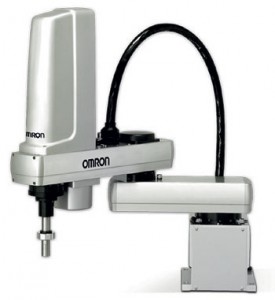Omron SCARA robots automate swab manufacture
 To eliminate tedious manual handling in the manufacturing process for water-testing swabs, manufacturing automation expert Secure Technologies Ltd has developed an efficient and cost-effective solution based on an Omron SCARA robot. This novel solution also makes extensive use of other Omron automation components, including laser sensors to accurately detect the position of the tiny swabs, and servo drives for accurate positional control.
To eliminate tedious manual handling in the manufacturing process for water-testing swabs, manufacturing automation expert Secure Technologies Ltd has developed an efficient and cost-effective solution based on an Omron SCARA robot. This novel solution also makes extensive use of other Omron automation components, including laser sensors to accurately detect the position of the tiny swabs, and servo drives for accurate positional control.
The swabs, which are manufactured by one of the world’s leading healthcare suppliers, resemble cotton buds with a specially formed end. After they emerge from the production line, they have to undergo further processing before they are ready for dispatch.
First they are dipped into a liquid reagent, and then allowed to dry for several hours. After the drying process is complete, each swab is placed in its own test tube. The finished products are supplied to end users as a swab in a test tube, which means that they are ready for immediate use without the need for additional equipment or apparatus.
Until recently, the swabs emerging from the production line were collected in a container from which they were manually removed and placed into trays with 500 compartments. The trays were then dipped and transferred to the drying cabinet. After drying, the swabs were manually unloaded from the trays, and placed in the test tubes. These manual processes were not only time consuming, but also repetitive and tedious.
Industrial robots are often thought of as expensive and complicated but, with the latest models, this is no longer the case
Because of its proven track record in implementing automation solutions for unusual applications, Secure Technologies, working in conjunction with Omron, was approached to develop an automatic handling system for the swabs that would eliminate the manual operations. After carefully analysing the end user’s requirements, the company decided on a solution with an Omron SCARA robot at its heart.
“Industrial robots are often thought of as expensive and complicated,” said Steve Badger, a director of Secure Technologies, “but, with the latest models, this is no longer the case. The truth is that modern robots, particularly those offered by Omron, provide exceptional flexibility in complex handling operations at a very reasonable cost.”
“In addition, today’s sophisticated robot control software makes programming straightforward, and modern robot control systems are designed to allow easy integration with other major automation components, such as programmable controllers and operator interface (HMI) units. We had no hesitation, therefore, in saying that a robot-based solution was the best approach for this project.”
Pinpoint accurate positioning
With the new handling system, swabs emerging from the production line fall onto a conveyor where their position is determined by laser sensors, which are used because of their ability to provide pinpoint accuracy. The robot then picks up each swab and transfers it to the 500-compartment tray, ready for dipping.
The position of the tray is indexed by servo drives during the loading operation, and the swabs fall into the compartments under the influence of gravity. This approach eliminates the risk of handling damage that might otherwise arise while loading the swabs into the compartments, which offer very little clearance.
When the tray is full – a process that now takes just eight minutes compared with the 30 minutes or more needed for manual loading – the robot dips it into the liquid reagent and then transfers it, via a rotary one-in-one-out magazine system, to the drying shelves. At the end of the drying period, the same robot retrieves the trays of swabs and unloads them one row at a time, each row being made up of ten swabs. Finally, the robot transfers the swabs to a vibratory feeder that conveys them to the test tubes.
Between the loading and unloading processes, the robot automatically changes the end effector that it uses to pick up the swabs from a type that handles swabs individually to a type that handles ten swabs simultaneously. This is an excellent example of the versatility and flexibility that can be achieved easily and economically with robot-based solutions.
 The Omron SCARA robot can work in four quadrants. In this project, only two quadrants are used – one for loading the swabs into the trays, dipping the trays and moving them to the drying shelves, and the second for unloading the trays. This leaves two operational quadrants free for future developments, which means that the present installation has room for considerable future enhancement and expansion at very little extra cost.
The Omron SCARA robot can work in four quadrants. In this project, only two quadrants are used – one for loading the swabs into the trays, dipping the trays and moving them to the drying shelves, and the second for unloading the trays. This leaves two operational quadrants free for future developments, which means that the present installation has room for considerable future enhancement and expansion at very little extra cost.
To complement the robot, the new automated swab-handling system uses an Omron CJ-series programmable controller (PLC), which provides overall control and also generates detailed performance and production information. This information is fed to the end-user’s back office systems via an Ethernet link.
The operator interface for the system is implemented with an Omron NS8 touch-screen HMI unit, which provides performance information in real time, and also allows access to historical operational statistics. The HMI panel is also used as the front end for a sophisticated engineering diagnostics and programming toolkit. This not only facilitates faultfinding, but also allows the operation of the system to be readily fine-tuned by, for example, making minor positional adjustments.
Before it was delivered to the end user’s site, the performance of the new system was carefully evaluated using product samples – 10,000 swabs were processed and the results 100% checked. The result was remarkable; not even a single defect was detected. A further target for the system was that it should require no more than one manual intervention per 1,500 swabs handled. It is easily exceeding this target – on average, only one manual intervention is needed per 16,500 swabs.
“While it would have been possible to develop a handling system that didn’t use robots for this application,” said Steve Badger, “it would have been bulkier, less flexible, more complicated and more expensive. In addition, by adopting the robotic approach, the end user now has a system which not only exceeds present day targets but also has ample capacity to handle additional demands.”
“Finally, thanks to the user-friendliness of the Omron products, and the excellent support and advice provided by the company’s applications support team, developing and optimising the robotic solution presented few difficulties or challenges. The end user is very pleased with the results and will, I’m sure, be favourably disposed to installing more robotic systems in the future.”
Visit the Omron website for more information.
See all stories for Omron















